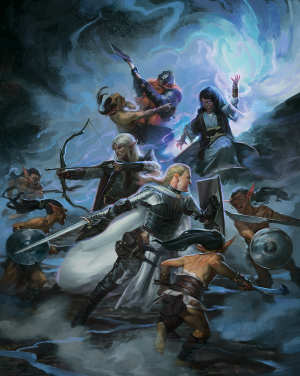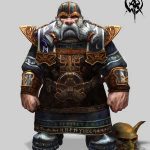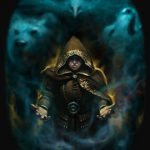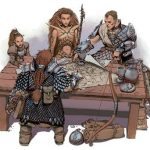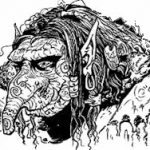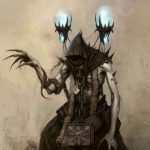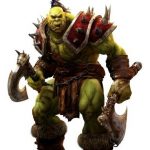Mass Combat System. By Joe Public (Gastaban). no rights reserved
This is based on Mongoose Publishing’s Open Mass Combat System, which is published in the Quintessential Fighter. You should also get this book to help fill any gaps that I miss. Feel free to adjust this as you feel it’s necessary.
Quick Definitions:
Unit – A self-contained group of individual creatures.
Individual – One member of a unit.
Units: All units need to be the same type of creature. If they’re different types, this system won’t work.
Unit Roster: These are the stats for a unit.
Race, Class, Hit Dice
Unit Size
Unit Hit points
Initiative
Attacks
Damage
AC
Ability Scores
Saves
Feats
Race, Class & Hit Dice: Self explanatory.
Unit Size: How many members are in a unit.
Unit Hit Points: multiply the average hp (as listed in the monster manual) by the Unit Size. If you don’t know the average hp (like, if they’re not monsters), then just roll up hp for one of the individuals and multiply that by the unit size.
Initiative: Same as individual in unit.
Attacks, Damage: Same as individual in unit.
AC: Same
Ability Scores: Same
Saves: Same
Feats: Same
Unit Combat: Many of these rules are the same as if 2 individuals were fighting each other.
Rounds: Same
Initiative: Before the first round of unit combat begins, each unit involved makes an initiative check. If the army’s general or the unit’s leader has the Leadership feat, the unit gets a +2 competence bonus to initiative.
Attack Roll: To score a hit that deals damage, a unit must roll the target’s armor class or better. melee and range attack rolls are done normally.
Damage: Any damage done is done to the entire unit. To calculate damage, follow the instructions below.
Melee attack: For every space where a unit is touching the other unit, those individuals in those spaces are able to do the damage. For example, if you have 4 guys in each space, and 2 of your unit’s spaces are touching the other unit, then 8 guys are doing damage. So you’d multiply damage done by 8.
Range attack: Multiply damage by the attacker’s unit size.
Unit Hit Points: When unit hit points reaches zero then the unit is wiped out.
Attack Options:
Charge: A unit not engaged in melee combat may charge any enemy with this option. They get +2 to attack roll, but -2 to AC. when a unit charges, they become mingled with the unit they charged (more on this in the miniatures section.). A unit cannot charge another unit if where is an obstacle blocking any part of the unit.
Attack: Either melee or ranged attack. If a unit can make more than one attack, it can do that with this option.
Withdraw: If involved in melee combat, a unit may attempt to withdraw. When a unit withdraws, the unit they’re in melee with gets an Attack of Opportunity against the unit. A unit cannot “double move” out to avoid an Attack of Opportunity.
Movement: Units move as if they were one category slower than normal. This is to simulate that the units are keeping their ranks intact.
Example: 30 ft would move 20 ft. 20 ft would move 15 ft. 15 ft would move 10 ft.
Wheeling: wheeling a unit means to rotate the way they’re facing. Wheeling a unit 45 degrees is half a move action, so the unit can still move half their distance in the direction they’re facing. Wheeling a unit 90 degrees takes a movement action. Wheeling a unit between 90 and 180 degrees takes a full round action.
Attacks of Opportunity: Attacks of opportunity are only used in unit combat when one unit attempts to withdraw from melee combat with another. Individuals who cast spells within a unit must be dealt with on an individual basis according to the core rules.
Other Considerations: any special abilities (such as barbarian rage) are used as a whole by the unit. if any individual in a unit uses a special abililty, he is no longer considered part of the group and should be dealt with according to the “individual vs. unit” rules.
Feats: Some feats are not used in mass combat. such as sunder etc, as these represent individual abilities, and don’t make sense on a large scale basis (all of the units weapons break? umm no) . Feats such as toughness however, are still used. Here’s a list of feats allowed in mass combat. Everyone (or at least 90% or more) in the unit must have the feat in order for the unit to use it.
Ambidexterity
Blind-Fight
Ear Shot
Endurance
Great Fortitude
Improved 2 weapon fighting
Improved unarmed Strike (if the units decide to punch each other. which i discourage)
Iron Will
Lightning Reflexes
Mounted Archery
Point Blank Shot
Rapid Shot
Ride-By Attack
Run
Spirited Charge
Toughness
Two-weapon fighting
Weapon Focus
Weapon Specialization
Individual VS. Unit Combat: Sometimes individuals will attack or be attacked by a unit. Such as a PC wanting to confront a unit, or an individual uses a special ability that transcends him from the ranks of the unit (like an individual polymorphs into a dragon. He is no longer part of that unit.)
Individuals in Unit combat will always be considered surrounded by the enemy, unless he can stop that somehow (wall of force for example). Otherwise, the maximum number of enemies will be around the individual at all times, for example, if a medium sized creature is fighting a unit of medium sized creatures, all with 5ft. by 5ft. face, than 8 enemies can attack the individual per round as per the core rules.
All attacks on this individual are considered flanking and receieve a +2 bonus to attack rolls.
If the individual is considered too powerful for any one individual in the unit he’s confronting, such as a high-leveled PC charging a unit of level 1 warriors, than the unit will use the Aid Another option as described in the Player’s Handbook. If the Aid Another option doesn’t work, the unit will attempt to grapple and pin the PC, as they consider the PC just too powerful for conventional attacks.
Miniatures: The use of miniatures is essential if you want to use this system. I’m sure you could just cut pieces of paper, but you’ll need some sort of visual representation.
Graph Size: Each graph square equals 20 ft. sq. you can change this, but you’ll have to alter other factors to compensate as this system considers each graph square to equal 20 ft. sq.
Unit space: This is how much space a unit takes up. Each miniature represents a certain number of individuals based on the face of each individual. Here’s a table of how many individuals fit in each square based on the face of an individual.
Face of Individual # in Square
2 1/2 x 2 1/2 64
5×5 16
5×10 8
10×10 4
10×20 2
20×20 1
Any excess men will be represented by another minitiature. For example, a unit of 40 human warriors (face: 5×5) will be represented by 3 miniatures. (2 for the 32 men. and another to represent the 8 left over.)
Mingling: When a unit charges another, the front row of miniatures will mingle with the other, thus sharing a space. This represents that the units are clashing. This means that men in the backrow may be adjacent to the enemy unit, and will add to the damage. This works both ways, since more of the enemy’s unit is touching more of yours.
Example: (the “&” represents unit-1 miniatures. The “$” represents unit-2 miniatures. the “X” represents mingled parts of a unit.)
&&&&
&XXX$$
$$$$$
In this diagram, all but the 2 $’s on the right of unit-2 can deal damage to the other unit.
Individual death: As individuals in a unit get killed, the miniatures must be removed to compensate the size. Units automatically reform when their individuals are killed.
Magic in Mass Combat: Most spells are used exactly as they do in the core rules. ie: a magic missile that does 5 damage, will do 5 damage to the unit.
Area of Effect Spells: Spells that cover a range of individuals within a unit, do a ton of damage to the unit. Damage done cannot exceed the number of hp within the area of effect. For example: a flame strike that does 30 damage is cast on a unit of human warriors with 10 hp each. if the flame strike only affects 5 of the individuals, then the hp damage the spell does is 50 hp (it killed all 5 warriors only. so the unit takes 50 hp. 5×10=50)
To determine how many individuals are affected, first, draw out the spell area of effect as a diamond shape on the graph paper (diamond shape is used for simplicity as circles are hard to draw. if you got a compass the use that), and count how many miniatures are within the affected area. (A lot of the spell will hit nothing as those squares won’t be occupied). if part of the area of effect only affects half of the miniature, then count that miniature as half affected.
Now take the number of miniatures affected, and multiply that by the number of individuals represented by each miniature. example: a fireball with a 40 foot diameter (20 ft radius), is cast on a huge unit of human warriors (face: 5×5). it is able to hit 2 miniatures (as the area of effect affects half of 4 miniatures.). 15 5×5 warriors can is represented by 1 miniature. so multiply 16 by 2 (number of miniatures affect) to get 32. that’s the number of men affected by the fireball.
Spells that cause affects other than damage (such as bless or bane) only provide their bonus or penalty to a unit if the majority (50% or more) can be affected.
Saving Throws: All saving throws are made by the unit as a whole.
The End of the Mass Combat: Not all individuals in a unit die. Some run away, and some are simply knocked unconcious or disabled one way or the other.
To determine surviving combatants: Roll precentage dice and divide the roll in half. If there’s healers, then add 1% per level of healer. 2% for clerics. Take this percentage and multiply it by the starting Unit Size. This is the number of survivors.
For the losers of combat. Do the same thing, however, the victors can decide if they want to finish those survivors off.
For more information, get Mongoose’s Quintessential Fighter. It has rules on Morale and Seige Engines.

